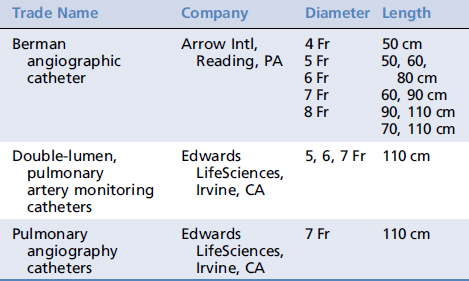Chapter 50 Pulmonary Artery Catheterization
TYPES OF CATHETERS AND USES
There are many types of pulmonary artery catheters (PACs) designed for angiographic studies or for measuring the blood pressure in the pulmonary arteries. These catheters may be single-lumen or double-lumen catheters.1 Some catheters designed to be introduced into the PA have sensors 4 cm distal to the tip of the catheter that allow temperature measurement (e.g., the Swan-Ganz type catheter). Other catheters may measure blood oxygenation (e.g., the oximetry thermodilution catheter) (Tables 50-1, 50-2, and 50-3). Diameters of thermodilution catheters range from 5 to 7.5 Fr. Angiographic catheters are available from 4 to 8 Fr. Most Swan-Ganz catheters are made of polyvinyl chloride (PVC) and are available in lengths of 75 or 110 cm, which are adequate for most small animal species, but which may not be of sufficient length for horses or other large animals. Other thermodilution catheters are made of polyurethane, which has the characteristic of softening at body temperature.
Cardiac Output
A PA catheter is necessary for evaluation of cardiac output using some thermodilution techniques (see Chapter 212, Cardiac Output Monitoring). Briefly, 1.5 ml/kg of saline (or 5% dextrose in water) of a known temperature is injected into the proximal port of the multilumen catheter.4 In most animals, this proximal port (30 cm proximal to the tip of the catheter) will sit either in the RA or in the jugular vein, where it is appropriate to inject the indicator bolus. As mentioned previously, placement of a second injection catheter in the RA may be necessary to perform thermodilution in smaller or larger animals.2,3 The thermistor probe on the distal end of the catheter will measure the change in blood temperature over time and will calculate cardiac output based on the area under the temperature curve. Newer Swan-Ganz catheters have thermistor probes near the junction of the proximal port and the catheter to more accurately measure the temperature of the injectate (it may warm significantly during injection). For larger animals such as horses, it is necessary to use chilled injectate, because subtle changes in blood temperature may not be sensed by the thermistor probe because of the relatively large cardiac output and blood volume in these animals. The indicator bolus must also be administered quickly, because a slow injection will minimize the change in temperature that is recognized by the thermistor and cause inaccurate readings (if injected too slowly, falsely low cardiac output measurement will be displayed). The use of a power injector pump is recommended for these measurements in large animals, and the bolus should be injected as quickly as possible in small animals.
Stay updated, free articles. Join our Telegram channel

Full access? Get Clinical Tree





